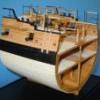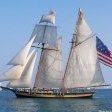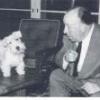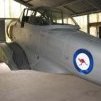Supplies of the Ship Modeler's Handbook are running out. Get your copy NOW before they are gone! Click on photo to order.
×
-
Posts
2,420 -
Joined
-
Last visited
Reputation Activity
-
 dvm27 reacted to russ in Centerboard Schooner C. Chase 1846 by Maury S - FINISHED - Scale 1:48
dvm27 reacted to russ in Centerboard Schooner C. Chase 1846 by Maury S - FINISHED - Scale 1:48
Maury:
Sorry to hear about the errors. I have been there. It taught me to never trust any drawing, but redraw and refair everything. I strongly support Druxey's advice on diagonals. Just when you think it looks right, draw out the diagonals and many hidden problems can be fixed.
On a centerboard hull, being shallow draft, I would advise, in addition to the horizontal waterlines, three or four buttock lines and the same number of diagonals. The buttocks will help fair the floor timbers down low in the middle of the hull. Without them, there is little to tell you anything useful below the lowest waterline. The diagonals in the body plan should run so that they cross the body sections at places in between where the waterlines and buttocks intersect the body sections. That will pick up those areas that the waterlines and buttocks do not address and give you several more points of intersections to ensure a fair drawing. It is a lot more work, but it will pay enormous dividends.
One thing to remember about the diagonals, and you have probably already seen this, the diagonals, when projected in the halfbreadth, will appear as convex curves or perhaps in some areas close to straight. However, they will not show as concave or hollow curves. This is because they approach the body sections at, or nearly at, right angles whereas the waterlines intersect at all sorts of shallow angles.
Good luck with the redrafting.
Russ
-
 dvm27 reacted to Forlani daniel in Chebece 1750 by Forlani daniel - FINISHED - 1:48
dvm27 reacted to Forlani daniel in Chebece 1750 by Forlani daniel - FINISHED - 1:48
Ciao e grazie a tutti
Hello and thanks to all
Un Saluto
-
 dvm27 got a reaction from mtaylor in HMS Atalanta 1775 by tlevine - FINISHED - 1:48 scale - from TFFM plans
dvm27 got a reaction from mtaylor in HMS Atalanta 1775 by tlevine - FINISHED - 1:48 scale - from TFFM plans
Bravo, Toni! I wouldn't know how to display her...unplanked side out, planked side out? They're equally exquisite.
Greg
-
 dvm27 got a reaction from mtaylor in Echo by davec - FINISHED - cross-section
dvm27 got a reaction from mtaylor in Echo by davec - FINISHED - cross-section
When drawing bamboo down to 0.018" they are barely perceptible on the model, especially if you sand the plank before installing them on the model. On your next model, where you'll have thousands of them, make sure you bamboo stock is fairly uniform. I ran out while making my last model and the replacement bamboo was decidedly darker.
-
 dvm27 reacted to Beef Wellington in HMS Jason by Beef Wellington - Caldercraft - 1:64 - Artois-class frigate modified from HMS Diana 1794
dvm27 reacted to Beef Wellington in HMS Jason by Beef Wellington - Caldercraft - 1:64 - Artois-class frigate modified from HMS Diana 1794
Well I'm back on track at least after the destruction, painful, but glad its behind me....
The bigger channels are completed now and ready to be glued into position, I'll be leaving the attachment of the smaller channels for the topmast backstays until after the quarterdeck is glued into position. A final finish has been put on the hull, which means that I can now start to put some of the detailing in place in conjunction with fitting the chains. There seem to be a number of position where space will be tight, so fingers crossed previous planning works out.
For reference, I've marked out the expected position of the quarterdeck ports (and the previous template position with a dotted line) but will not be cutting these out until the quarterdeck is in place. This shows them in relation to the actual position of the deadeyes, with a bit of imagination (I used string and a mock up of the masts) its clear that the previous port locations would be obscured (the second and third from the stern are the tricky ones). Even though not obscured, the 4th port from the rear was moved so the port separation is equalized as much as possible. My advice to anyone modifying the kit (or even building from the box) is to leave the positioning and cutting out of any these quarterdeck ports until after the final position of the deadeyes is known.
Unfortunately, the PE hinges supplied in the kit are too small and dimension, and too bulky, for the sizes of the sweep/airing ports estimated from the AOTS plans. Luckily I had purchased a PE set for (I think!) the HMS Grenado way back and it contains some useable hinges. These smaller PE sets are pretty reasonably priced, and I've found can be handy to have as they contain a multitude of potentially useful fittings (hooks etc.) which can be used to supplement the older 'bare bones' CC kit PE sets.
These were given a few coats of paint to bulk them up a bit as although they are theoretically the same scale, the ports on Grenado are of smaller dimension. Placement on the airing ports proved a little challenging due to the elevated profile of the black-strake that runs through these.
-
 dvm27 reacted to EdT in Young America 1853 by EdT - FINISHED - extreme clipper
dvm27 reacted to EdT in Young America 1853 by EdT - FINISHED - extreme clipper
Young America - extreme clipper 1853
Part 305 – Spanker Gaff 2
(First a side note: While I very much appreciate some of the supportive comments following my last post, I deeply regret that we are having this dialogue at all. In the almost 6 years of regular posting on this site I have been very grateful for the comments, questions, suggestions, and yes, the constructive criticism that my work has received. In return I have done my best to answer all questions, explain detailed aspects of the work, appropriately adopt suggestions for improvement, and to improve the posts based on what followers seem to want. I truly hope that this will not be disrupted by any of my recent comments. I wish there were sufficient time to address every comment adequately, even those that require time consuming analysis, careful response, and yes, polite rebuttal. Unfortunately, time is limited. I only ask that my need to prioritize be acknowledged.
Some basic clarification of the basis of my rigging work may help. There is no set of plans or definitive data describing the full rigging of Young America. The ship had a 30 year career, several different owners, and many different captains. The ship evolved from the extreme clipper concept of her early career to the more mundane plodding of her later years. Her career spanned a period of major changes in ships' rigs as chain, wire, and new iron fittings emerged. For these reasons I have never represented that my design is a replica of the actual ship or any other ship. The design is based on input from the best primary and secondary documented references available to me. Thanks.)
The first picture shows the spanker gaff with all its rigging installed.
A simple lashing between eyebolts on the throat was used to fasten the gaff to the spanker mast. In the picture the two lines slanted down to the deck in an inverted V are the vangs. These long pendants with tackles control the sweep of the gaff. A signal halyard is run through a block at the end of the gaff and belays on the iron rail. The next picture provides a better view of the peak halyard and other rigging to the gaff.
The standing end of the peak halyard is fixed to the topmast crosstrees, runs down to a single block near the end of the boom, back through a double block at the cap, through another single block on the gaff, back through the cap block, then down to belay on the mast spider band.
The head outhauler may be seen in the next picture.
The standing end of the outhauler is stopped under the gaff at the gooseneck. It then runs under the gaff to the sheave at the end, back through a single block hooked under the port side of the cap, thence to a tackle hooked on the deck and belayed on the port pin rail. The tackle is long enough to allow the standing end of the line to be hauled out to the end of the gaff.
The next picture shows the throat halyard tackle under the top.
The throat halyard tackle that was used to raise the entire gaff is hooked under the port trestletree and to the throat of the gaff. The fall then runs down along the mast to be belayed on the spider band. The picture also shows the head outhauler stopped off in the block under the gaff throat band. The line stopped in this block is the head inhaul (or downhaul) used to take in the sail at the top. This line also runs down to a tackle on the deck aft of the throat tackle. The next picture shows the two tackles. The inhaul tackle is almost block-to-block since the inhaul is fully overhauled to the gaff throat – waiting for a sail.
It will be nice to get rid of this unsightly masking tape but for now it is a lifesaver in keeping rope and other debris out of the decks below.
Ed
-
 dvm27 got a reaction from Landlubber Mike in "Wooden Warship Construction" by Lavery
dvm27 got a reaction from Landlubber Mike in "Wooden Warship Construction" by Lavery
It's a nice little book with beautiful color photographs but hardly comprehensive. Those wishing a more complete treatise on the subject would could do no better than Englishman of War 1600-1850 by Peter Goodwin or Arming and Fitting the English Ships of War 1600-1815 by Brian Lavery
-
 dvm27 got a reaction from MEDDO in Echo by davec - FINISHED - cross-section
dvm27 got a reaction from MEDDO in Echo by davec - FINISHED - cross-section
When drawing bamboo down to 0.018" they are barely perceptible on the model, especially if you sand the plank before installing them on the model. On your next model, where you'll have thousands of them, make sure you bamboo stock is fairly uniform. I ran out while making my last model and the replacement bamboo was decidedly darker.
-
 dvm27 reacted to michael mott in Bristol Pilot Cutter by michael mott - 1/8 scale - POF
dvm27 reacted to michael mott in Bristol Pilot Cutter by michael mott - 1/8 scale - POF
Thanks Ed, and for all those who added likes.
Today I started on the brass metalwork for the two plates at the entrance to the companionway and for the top rails. first order of the day was to cut some strips from the .031" sheet stock. I cut 3 pieces 1/4" wide and one 1/2" wide. I used my new 200x 1.2mm slitting saw on the big table saw. I was really pleased with the resulting cuts.
and a close up of the edge straight off the saw.
after measuring the vertical plates I cut the angles with the jewelers saw. The port side one was a bit sloppy on following the line .
The starboard one was a lot better.
Next the holes were drilled and countersunk for the fake 3/8" scale wood-screws.
The small copper Sig rivets had a head diameter of .055" and shaft of .023" I chucked these in a pin vice in the lathe and filed the pan head to a countersink profile.
Tomorrow or later today I will fit them to the companionway. which has been sanded ready for the canvas and the capture runners
Michael
-
 dvm27 reacted to archjofo in La Créole 1827 by archjofo - Scale 1/48 - French corvette
dvm27 reacted to archjofo in La Créole 1827 by archjofo - Scale 1/48 - French corvette
Hello Pete,
thank you for your appreciation of my work.
A few days ago I received the linen yarn from Bockens NeL 120/2 and Goldschild NeL 100/3 and immediately struck a rope with 2 threads per hook. For the linen yarn of Goldschild NeL 100/3, this resulted in a rope with ø 0.75 mm (on the right in the picture) and for the linen yarn of Bockens NeL 120/2 a rope with ø 0.55 mm (left in the picture).
These yarns are a lot thinner, like those already presented. This makes it possible to make even the thinnest ropes I need in the upper rigging for the La Crèole.
Of course, practice is still required. It gets better from rope to rope; the experience is steadily increasing and it's even fun.
Surely it will be even better, but for now from my point of view as good.
Here are some more Experiments (left to right):
DMC Ecru No. 100 6 x 3 rope diameter 1.40 mm; cotton
DMC Ecru No. 80 6 x 3 rope diameter 1.50 mm; cotton
DMC Ecru No. 80 8 x 3 rope diameter 1.65 mm; cotton
DMC Ecru No. 100 1 x 2 rope diameter 0.45 mm; cotton
Alterfil No. 120 2 x 3 rope diameter 0.58 mm; polyester
Bock's No. 470 NeL 120/2 8 x 3 rope diameter 1.25 mm; linen
-
 dvm27 reacted to Chuck in Medway Longboat 1742 by Chuck - FINISHED - 1/2" scale
dvm27 reacted to Chuck in Medway Longboat 1742 by Chuck - FINISHED - 1/2" scale
Thank You
I added the fixed block at the stem on the starboard side. Its pretty straight forward. You only need one but I laser cut a bunch of extras for you guys because its tiny. Just in case.
Glued the small pieces to the back like this.
Inserted 22 gauge black wire and snipped it off flush on the outside but left it sticking out on the other for the sheave.
Used 10 lb fishing line to make the four bolts as shown on the plans. Sanded it and rounded off the edges.
Added the sheave but with no glue so it will be a working sheave. Not that it really matters.
Then I glued it on the stem.
Pretty straight forward
-
 dvm27 reacted to Chuck in Medway Longboat 1742 by Chuck - FINISHED - 1/2" scale
dvm27 reacted to Chuck in Medway Longboat 1742 by Chuck - FINISHED - 1/2" scale
The Windlass is completed and installed. All I had to do was reduce the ends of the windlass until they were cone shaped and able to fit into the slots of the brackets. I just dis this by hand a little at a time with some sandpaper. I constantly tested and adjusted the cone shape until it slid into the slots easy enough. This meant shortening each side slightly.
The brackets are laser cut. I removed the char and added the bolts while off the model. I used black fishing line as usual. The brackets are glued directly to the riser between the thwarts but actually under them. This left a space on the bottom edge between the frames and the bracket as expected where it hangs below the riser. So before gluing it into position, I added a 1/16" x 1/16" strip to the back, bottom edge of the bracket first. This made it so the bracket was seated firmly against the frames and riser. Before adding the bolts I held the bracket against the riser so I could mark the locations for them. You can see how some line up with the frames. While others are just into the riser. This detail is shown on the plans.
The two windlass bars were shaped from a 1/8" x 1/8" strip. I just rounded off one end as you see below by chocking it in my hand drill. Then I squared off the other end as shown on the plans so they would fit in the square holes of the windlass. I will only show one in position and just rest the other atop the thwarts. But in the photos you see both installed just for the fun of it.
-
 dvm27 got a reaction from Martin W in HMS Atalanta 1775 by tlevine - FINISHED - 1:48 scale - from TFFM plans
dvm27 got a reaction from Martin W in HMS Atalanta 1775 by tlevine - FINISHED - 1:48 scale - from TFFM plans
Bravo, Toni! I wouldn't know how to display her...unplanked side out, planked side out? They're equally exquisite.
Greg
-
 dvm27 reacted to marsalv in Le Gros Ventre by marsalv - FINISHED - 1:48 - POF
dvm27 reacted to marsalv in Le Gros Ventre by marsalv - FINISHED - 1:48 - POF
After a long creative vacuum, I started a new project. This is the so-called "gabare" Le Gros Ventre at 1:48 scale, the model will be realized using the POF method (plank on frame) according to a monograph by Gerard Delacroix. I will use cherry, pear, black hornbeam and maple wood for the building, without painting.
Gabare is a cargo ship used by the French Royal Navy during the 18th and 19th centuries. For this reason, there is no orlop deck.
The first phase of the construction was the making of a building board necessary for the installation of frames on the keel. Great attention must be paid to the maximum accuracy of the position of the bottom and top base.
-
 dvm27 got a reaction from PeteB in HMS Atalanta 1775 by tlevine - FINISHED - 1:48 scale - from TFFM plans
dvm27 got a reaction from PeteB in HMS Atalanta 1775 by tlevine - FINISHED - 1:48 scale - from TFFM plans
I was also a bit disappointed when I finished my Druid decking and it yellowed a bit. I've found that dilute sanding sealer is the only way to keep holly white.
The model looks terrific.
-
 dvm27 reacted to MEDDO in Seawatch Books
dvm27 reacted to MEDDO in Seawatch Books
Great company and great service. I just received this today. I had ordered the book (and received it) back when it was first available.
-
 dvm27 reacted to Kevin Kenny in America 1851 by Kevin Kenny - FINISHED - Constructo
dvm27 reacted to Kevin Kenny in America 1851 by Kevin Kenny - FINISHED - Constructo
Different size mast hoops
-

-
 dvm27 got a reaction from druxey in HMS Atalanta 1775 by tlevine - FINISHED - 1:48 scale - from TFFM plans
dvm27 got a reaction from druxey in HMS Atalanta 1775 by tlevine - FINISHED - 1:48 scale - from TFFM plans
Bravo, Toni! I wouldn't know how to display her...unplanked side out, planked side out? They're equally exquisite.
Greg
-

-
 dvm27 reacted to BETAQDAVE in MONTAÑES by Amalio
dvm27 reacted to BETAQDAVE in MONTAÑES by Amalio
Aside from the superb precision of your wood joinery and components (more like a fine piece of furniture), I find the fact that your rigging here is so well done that it is worth a separate mention of note. Your lines are more like what one would expect to see in full sized rope as they have an incredibly realistic drape to them, as if they have real heft to them rather than looking like the fine thread found in most models that have essentially no real weight to them! If one didn't know that this was just a model, you could almost swear that this is a photo of a full size replica!
-
 dvm27 reacted to shipmodel in USS/SS Leviathan 1914 by shipmodel - FINISHED - 1/200 - troop ship/ocean liner
dvm27 reacted to shipmodel in USS/SS Leviathan 1914 by shipmodel - FINISHED - 1/200 - troop ship/ocean liner
Hi to those of you who are following along, and those just looking in. I hope to make this journey informative and enjoyable for all, as it has been for me. Just hit the 'like' button if I am succeeding.
The research for the project started, as with all my models of modern ships, by surfing what could be easily reached on the internet. Wikipedia gave me the basic history that I summarized in segment one, along with a few photographs.
I always look at the research notes and sources at the bottom of a wiki article, which led me to the photo archives of the Naval History and Heritage Command (www.history.navy.mil), also known as the Naval Historical Center. This is a site maintained by the US Navy, and any of the photos that can be seen there are in the public domain. Fortunately, they had over 200 photos of her taken mostly while she was a troop ship during WW I, including this shot of one of the 6-inch guns that were installed so she could defend herself.
Another excellent site is NavSource Naval History (www.navsource.org), an organization of volunteers who put together histories and photographs of US Navy vessels. Here there were many more photos, not just limited to those of her as a troop ship, but included those of her as the SS Vaterland before the war and as the SS Leviathan after the war. However, many of the images are copyright protected and so I used them only for research.
A wider net was cast by searching Google images under all three names of the ship and a flood of photographs were found. Everything from high-resolution images of the liner’s deckhouse to low res blurry shots of the troop ship being filled with coal.
Side branches led me to even more images. One of those was to an image of the cover of a huge six volume set of books by Frank O. Braynard, a noted maritime historian, prolific author, and one of the founders of South Street Seaport museum and historic area New York.
The books were available on the net, but for a minimum of $200 for the set. Fortunately, the Merchant Marine Academy museum has a set, which I devoured. Here I found many more photos that I had not seen before. Unfortunately, the books had been produced in sepia-tone, and the images had lost some resolution in the process. I scanned those that gave me viewpoints that I did not already have, converted them to greyscale and played with contrast and lighting to get as much information out of them as I could.
My final resource for images was a man I was introduced to by Professor Smith. Richard Rabbett of Boston is a liner enthusiast, especially Leviathan. He has studied her for years and has an impressive collection of artifacts, photos and knowledge. He even moderates a Facebook group about the ship at https://www.facebook.com/groups/ssleviathan/ He has generously given his time and advice to the project. Even now I rely on him when there is a particular perspective or camera angle that I do not have.
From all of those I selected about 200 that cover just about every square inch of the exterior of the ship in as much detail as possible. Some, like this aerial view, from Richard, are unique and had to be included, despite the long range and some resolution problems.
Getting a good set of plans was less easy. There are no complete ones that could be located either through a plans company or on the net, although some individual deck plans were found. They were incomplete and some were poorly rendered. I did find a good cross-section drawn by Gibbs & Cox during the conversion from troop ship to liner, but only a few deck plans.
Nor was there a full set in the Braynard books. Some were printed on the inside covers, but they ran across the fold so some dimensions are questionable. Some others are labelled in German, so they must be plans of the SS Vaterland, before two conversions, and could only be relied on for the general outlines of the decks. Even the historian at Newport News Shipbuilding, where the last conversion took place, could not find a complete set, yet I know that it must exist, because Richard Rabbett has a set from the conversion. But his are both too large and too fragile to flatten for a scan. He took photos of them for me, but they would need a lot of work before they could be used to base a model on.
Nonetheless, I managed to assemble digital images of almost all of the deck plans from the waterline up. They were dropped into Photoshop, cleaned up and cropped. Then each one needed to be straightened out, since most were scans of paper plans which had warped over time. A centerline was established and each warped segment of the plan was returned to center using the skew and distort functions of the program. They were resized to the 57” LOA of the model and assembled vertically in one image. I used the G&C cross section as my guide, and adjusted each deck plan to match it. Ultimately, this is what I came up with. It is highly reduced here, but it scans as 19,500 px by 27,000 px (119 megabytes) and would be 6’ x 9’ if printed full size.
This plan got taken apart and assembled into two ‘cutting plans’ for convenience, then taken to the blueprint service company where three sets were printed out.
At the top of cutting plan 1 is what I call the ‘porthole plan’. I took the plan for the exterior hull which I mirrored vertically so I would have the locations of every porthole, door and fitting on the hull, both port and starboard. Small sections of the bow and stern were also included from which I made templates to help shape the hull. Finally, I put together a triple image of the exterior plan, an exterior photo, and a plan view of the ship which I could easily consult during construction.
This process took several weeks, during which I also ordered wood, surfed the net for fitting and fixtures, and got the shop in the upstate house cleared and cleaned. Next segment, we start cutting wood.
Till then, be well
Dan
-
 dvm27 got a reaction from mtaylor in "Wooden Warship Construction" by Lavery
dvm27 got a reaction from mtaylor in "Wooden Warship Construction" by Lavery
It's a nice little book with beautiful color photographs but hardly comprehensive. Those wishing a more complete treatise on the subject would could do no better than Englishman of War 1600-1850 by Peter Goodwin or Arming and Fitting the English Ships of War 1600-1815 by Brian Lavery
-
 dvm27 got a reaction from popeye the sailor in Bristol Pilot Cutter by michael mott - 1/8 scale - POF
dvm27 got a reaction from popeye the sailor in Bristol Pilot Cutter by michael mott - 1/8 scale - POF
Either you have very small hands or that's a very large model, Michael. Exquisite work!
-
 dvm27 got a reaction from druxey in "Wooden Warship Construction" by Lavery
dvm27 got a reaction from druxey in "Wooden Warship Construction" by Lavery
It's a nice little book with beautiful color photographs but hardly comprehensive. Those wishing a more complete treatise on the subject would could do no better than Englishman of War 1600-1850 by Peter Goodwin or Arming and Fitting the English Ships of War 1600-1815 by Brian Lavery









